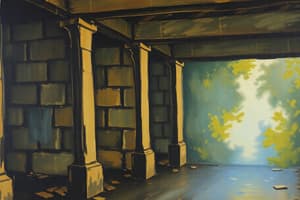Podcast
Questions and Answers
What does AASHTO stand for and what is its primary focus?
What does AASHTO stand for and what is its primary focus?
AASHTO stands for the American Association of State Highways and Transportation Officials, focusing on improving transportation systems.
Identify two key focuses of AREMA in relation to railway engineering.
Identify two key focuses of AREMA in relation to railway engineering.
AREMA, or the American Railway Engineering Maintenance-of-Way Association, focuses on railway engineering practices and maintenance of railway infrastructure.
List three types of environmental loads that structures must consider.
List three types of environmental loads that structures must consider.
Structures must consider snow loads, wind pressure and suction, and earthquake loads.
How do temperature differentials impact structural loads?
How do temperature differentials impact structural loads?
Explain the significance of considering soil pressures in structural design.
Explain the significance of considering soil pressures in structural design.
Flashcards are hidden until you start studying
Study Notes
Key Organizations in Transportation
-
AASHTO:
- Stands for American Association of State Highways and Transportation Officials.
- Plays a crucial role in developing standards and guidelines for highway and transportation infrastructure in the U.S.
-
AREMA:
- Stands for American Railway Engineering Maintenance-of-Way Association.
- Focuses on improving railway engineering practices and maintenance of railway systems in North America.
Environmental Loads on Structures
-
Snow Loads:
- Weight of accumulated snow on structures must be accounted for in design.
-
Wind Pressure and Suction:
- Structures must be engineered to withstand varying wind forces that can exert pressure or suction.
-
Earthquake Loads:
- Structures in seismic zones need design considerations for potential earthquake-induced forces.
-
Soil Pressures on Subsurface Portions:
- Subsurface designs must address pressures from surrounding soil to ensure stability.
-
Rainwater Ponding:
- Flat surfaces must be designed to handle loads from potential water accumulation during heavy rainfall.
-
Temperature Differentials:
- Thermal expansion and contraction forces should be incorporated in structural design to prevent damage.
Studying That Suits You
Use AI to generate personalized quizzes and flashcards to suit your learning preferences.



